Play it again, Joe
Sep 18, 2009

And many happy returns of the day.
Sep 18, 2009

And many happy returns of the day.
Nov 15, 2009
All right, not seventy-six, but definitely one trombone in this band-sextet-plus-string-quartet from the U.S. Marine Corps Band in 1910. And a double-belled euphonium--for real! Over there at the right.
Do you remember the double-bell euphonium, from "Seventy-six trombones" in Meredith Willson's Broadway show "The Music Man"? I'd thought it was a joke, a made-up instrument that the ignorant folks of River City, Iowa, would believe was real. But I guess it was actually more of an in-joke, a real band instrument of the era, with a name so silly that only the cognoscenti would believe it. As always, I ain't no cognoscenti.
This photo is from the middle of the era celebrated in "The Music Man," when towns all over America built bandstands in the park and organized their own brass bands. In the cities, commercial brass bands were making big money. John Philip Sousa, everybody's favorite bandmaster and composer, had joined the Marine Band at the age of thirteen and conducted it long enough to play for five presidents. But before the turn of the twentieth century, Sousa left the Marines to seek his fortune with the baton of his own Sousa Band, which was wildly successful and became the first American musical organization to tour Europe. In the 1920s, the piccolo player in the Sousa Band was none other than Meredith Willson, who who spent the next thirty years working on music and lyrics for "The Music Man," which finally debuted in 1958.
Today's Marine Band is still "The President's Own" and the premier ensemble of the U.S. military, which claims to employ more musicians than any other organization on earth. The band uniforms haven't changed much in the past ninety-nine years, though the shoes are much shinier nowadays.
Oh, and here's "Seventy-six Trombones," as performed by the trombone choir of Anchorage, Alaska.
May 8, 2011
 The Mississippi River is flooding now, cresting at Memphis near record levels and adding water from swollen tributaries as it rolls on south toward New Orleans.
The Mississippi River is flooding now, cresting at Memphis near record levels and adding water from swollen tributaries as it rolls on south toward New Orleans.
By all accounts, flood crests along the southern part of the river will reach the highest levels ever recorded during the next ten days or so. Although little new rain is expected, snow melt from up north plus spring rains totaling 400 percent of normal throughout broad stretches of the Midwest and South have filled the river system far beyond capacity.
The worst recorded Mississippi floods–probably the worst single disaster in American history–came in 1927, when levees were overtopped and undermined in literally hundreds of places, stranding more than a million people in high water, many of them for three months or longer. Among the ironies of this disaster is its hero, U.S. Secretary of Commerce Herbert Hoover, who organized rescue and relief operations that were so impressive his performance propelled him all the way to the presidency the next year, in which office he stood idly by while the country sank into the Great Depression.
Depression-era public works projects improved the levees and supplemented them with floodways–gates in the levees opening onto back channels that could be intentionally flooded when necessary, taking pressure off the levees during high water. But the water ran even higher in 1937 than in 1927, and again almost a million people were flooded out of their homes. Among the ironies this time: the rains that caused this flood were what finally put an end to the long Dust Bowl drought.
Again, flood defenses were strengthened, and the next time the river ran really, really high, in 1973, flooding was severe but not catastrophic. However, the 1973 floodwater did damage the "Old River Control Structure," shown here, which is key to the entire lower Mississippi Valley as we know it–and which is at risk now, in the highest flood the river has ever seen.
The Old River Control Structure is a Rube Goldberg sort of complex designed to keep the Mississippi River from abandoning its channel and finding a new route to the Gulf of Mexico. Like all rivers, the Mississippi constantly tries to create new distributaries near its mouth, where it has deposited so much sediment that it's blocking its own flow. In the nineteenth and early twentieth century, the Army Corps of Engineers helped this process along by dredging new channels to shorten shipping routes and removing huge logjams that trapped river sediment. Year after year, more and more of the Mississippi left its banks and drained west through the Atchafalaya swamp, eventually reaching the Gulf near Morgan City, Louisiana, far to the west of New Orleans and the current river delta.
The Atchafalaya swamp drainage eventually scoured out a river channel, which could efficiently drain even more of the Mississippi water. Scientists predicted that by 1980, the entire river would reroute itself into the Atchafalaya basin, permanently flooding Morgan City and other communities near the swamp. The cities of New Orleans and Baton Rouge, with their huge ports, refineries, and other industries, would no longer be connected by a deepwater river to the rest of the country; a little water would still travel in the old riverbed, but it would become brackish, shallow, and slack, like all the other Gulf of Mexico bayous.
This would be economically devastating to the region and perhaps to the entire country, since we would lose massive amounts of petroleum and transportation infrastructure. New Orleans and environs would lose their drinking water and much of their economic function. The entire population of Morgan City would have to be relocated.
To prevent all this catastrophe, Congress passed a law against the Mississippi changing its course. Literally, the law requires that at least 70 percent of the river water stay in the current river channel all the way to the Gulf of the Mexico; only 30 percent can legally flow the way it now wants to flow, to the west through the Atchafalaya.
To enforce this law, the Corps of Engineers built the Old River Control Structure, which partially failed in the 1973 flood. They reinforced the original structure and added new auxiliary features to help out. The question now is whether this new control system can stand up to the record-level flooding of 2011.
If it fails, the lower Mississippi will most likely never again return to its banks. Already, in the forty years since the Control Structure went into effect, Mississippi mud deposited by the riverwater has built up the Mississippi's bed near Old River till it is about five or six feet higher than the Atchafalaya river there; a hydroelectric power plant has been built on site to take advantage of the elevation drop, and a lock and dam had to be built to handle ship traffic. Obviously, if the river there were left to its own devices, it would respond to gravity like any other river and dive over this five-foot drop, hurrying along to the Gulf of Mexico, New Orleans be damned.
The key metric is three million cubic feet per second; that's the "project flood," the maximum flow the Old River Control Structure was built to handle. It's not been tested at anything close to that level; it will be tested now, beginning around May 19. We can hope.
The video below shows images from the 1937 flood, to the song by Johnny Cash recalling his boyhood experience of that flood in Dies, Arkansas.
Jun 10, 2011
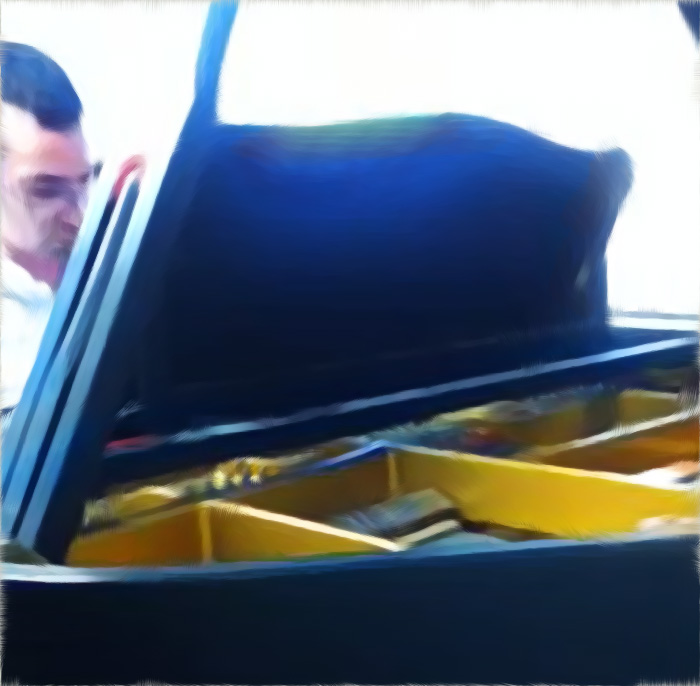 Joe tickles the ivories, playing a lullaby he composed for a friend's new baby.
Joe tickles the ivories, playing a lullaby he composed for a friend's new baby.
Jul 8, 2011
 Every few minutes at Victor Cafe in South Philly, one or another of the servers rings the little bell seen here on a tabletop and bursts into song.
Every few minutes at Victor Cafe in South Philly, one or another of the servers rings the little bell seen here on a tabletop and bursts into song.
They all have operatic training, so usually they sing opera, which is what the crowd came for–and they do draw a crowd. But as the evening progresses, the repertoire loosens up a little; they belt out showtunes as well as arias, and they even take requests. Here, at the end of the night, a tenor working as a waiter closes down the place with that old pop standard, Ave Maria.
Jul 22, 2011
 Piano recital season has come around again.
Piano recital season has come around again.
I took piano lessons as a child, as did my sister, but we had different teachers and thus had to attend each other's recitals as well as our own. My teacher organized mercifully brief programs; we took our turns at the keyboard in the school cafeteria, curtsied, raced through our pieces, and then it was time for the cookies, punch, and dixie cups of vanilla ice cream. But my sister's recitals, in her teacher's living room, were endless, and there were only enough chairs for the grownups; all the brothers and sisters had to sit on the steps while the piano-playing went on and on and on. Many of the students were extremely talented–one of them now conducts a symphony orchestra–but what I mostly remember is how long we had to sit there before the cookies and punch.
These children were among a couple of dozen who performed their recital pieces the other day on the Steinway grand at Strathmore Mansion in Rockville, Maryland. They are students of B&B Music School.




Aug 28, 2011
 Well, I didn't know there really was such a thing as the Big Rock Candy Mountain, but here it is, rising above a resort with the same name along Highway 89 near Marysvale, Utah.
Well, I didn't know there really was such a thing as the Big Rock Candy Mountain, but here it is, rising above a resort with the same name along Highway 89 near Marysvale, Utah.
Volcanic explosions, followed by magmatic intrusions, followed by twenty-odd-million years of erosion and hot-springs-type chemical interactions have streaked the mountain with colorful mineral deposits. The reddish rocks contain iron-based minerals, including hematite and pyrite, while the whitish rocks contain potassium-based minerals, notably including kaolinite, a valuable white clay used to make paper glossy for magazines or photos.
The mineralization of Big Rock Candy Mountain acidifies runoff water, leaving the soil here relatively inhospitable to vegetation. Nonetheless, ponderosa pine are hanging on, especially near the ridgetop.
It's hard to imagine that in the 1930s there would have been anything about this part of the world that was hospitable to hoboes, either. No lemonade springs, no lakes of stew and whiskey too, no cigarette trees, nothing but more of the longing and aching that inspired Harry McClintock's song.
Jan 22, 2012
 This past Friday, the temperature in Madison, Wisconsin, at high noon was 10 degrees Fahrenheit. It snowed all day. But just as on every other weekday since last March 11, a crowd gathered on the steps of the state capitol building for a boisterous Solidarity Sing-Along. These folks are among the same volunteers who recently collected more than a million signatures of voters around the state to ensure a recall election that they hope will depose their anti-labor "Governor Lazy" Scott Walker.
This past Friday, the temperature in Madison, Wisconsin, at high noon was 10 degrees Fahrenheit. It snowed all day. But just as on every other weekday since last March 11, a crowd gathered on the steps of the state capitol building for a boisterous Solidarity Sing-Along. These folks are among the same volunteers who recently collected more than a million signatures of voters around the state to ensure a recall election that they hope will depose their anti-labor "Governor Lazy" Scott Walker.
Apr 10, 2012

Brittany Howard, lead singer of the Alabama Shakes, released her first CD today and played to a sold-out house last night at World Cafe in Philadelphia. I'm not a music reviewer; I won't try to describe or evaluate the performance, but I sure wouldn't quibble with the critics who have been comparing Howard to Janis Joplin, Otis Redding, James Brown, and just about every other legendary rock-soul-blues singer. She's got Brown's energy and Joplin's wail and Redding's sweetness and even a little of Hank Williams's falsetto--plus the whole history of rock and roll in the songs she writes and the licks she picks.
The rest of the band is tight and fine, but they're just along for the ride.
What do you think?
May 6, 2012
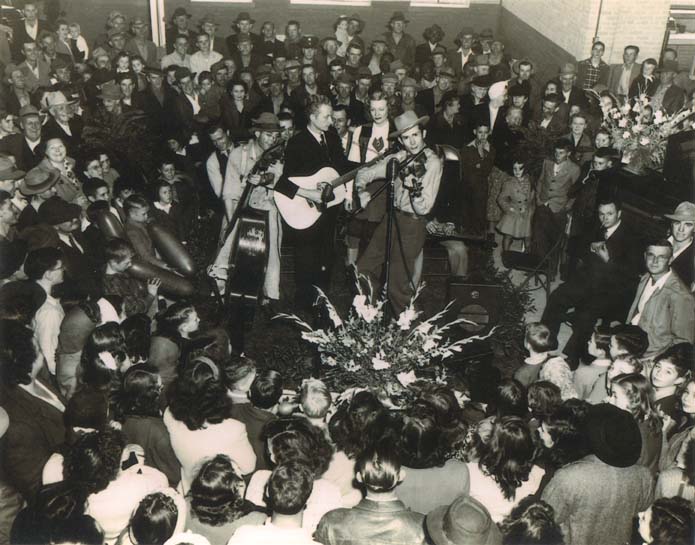 In 1946, a 23-year-old singer-songwriter named Hiram Williams, somewhat better known to the world as Hank Williams, performed with his band at the opening of a new Chevrolet dealership in Luverne, Alabama. That's him with the fiddle, an instrument he did not perform on very often.
In 1946, a 23-year-old singer-songwriter named Hiram Williams, somewhat better known to the world as Hank Williams, performed with his band at the opening of a new Chevrolet dealership in Luverne, Alabama. That's him with the fiddle, an instrument he did not perform on very often.
It was either the evening of this show in the Chevy parking lot, or the night of a street dance right around that same time, a fundraising dance sponsored by the Luverne volunteer fire department, when Hank Williams passed out drunk and had to be driven back home to Montgomery, an hour away. The designated driver was Howard Morgan, then captain of the Luverne fire department. "Hank Williams wasn't anything special in those days," Morgan recalled. "Just another cowboy singer."
Chevy dealership openings and volunteer fire department fundraisers were pretty much the only work Williams could get at that time; he'd been fired from his radio show for "habitual drunkenness," and a few months earlier he'd flunked his audition at the Grand Ole Opry. But he'd just made his first recording, which he may or may not have performed in Luverne that day: "Wealth Won't Save Your Soul."
His first record was a dud commercially, but by early 1947, with "Move It On Over," Hank Williams was on fire. During the next six years he wrote and recorded thirty songs, eleven of which made it to number one on the charts. His concerts all over the country drew thousands of adoring fans; never again would he have to perform in a Chevy dealership parking lot in Luverne, Alabama.
His final recording, a few weeks before his death on January 1, 1953, from abuse of alcohol, amphetamines, seconal, chloral hydrate, and morphine: "I'll Never Get Out of This World Alive."
On January 4, 1953, the city of Montgomery, Alabama, saw the largest crowd in its history gather to pay final respects to Hank Williams and to listen to Nashville stars performing his greatest hits. The funeral had to be moved to the city convention hall. Luverne volunteer fire chief Howard Morgan and his family were in Montgomery that day, stuck in traffic as the line of funeral-goers stretched for miles. Our friend Martha Morgan was two years old at the time, sitting in the backseat, too young to understand the occasion but definitely alert to the scene, to the sight of car after car after car after car; Hank Williams's farewell traffic jam became one of Martha's earliest childhood memories.
May 1, 2012
 For an advertising campaign to promote the Berlin Philharmonic, Munich photographers Andreas Mierswa and Markus Kluska somehow shot pictures that appear to be looking out, or trying to look out, from inside musical instruments.
For an advertising campaign to promote the Berlin Philharmonic, Munich photographers Andreas Mierswa and Markus Kluska somehow shot pictures that appear to be looking out, or trying to look out, from inside musical instruments.
Aug 10, 2012
 At the feet of the fiddler in this picture is his open violin case, with a hat in it. He is riding the Washington State ferry that crosses Puget Sound between Edmonds and Kingston, just north of Seattle. I don't know if he's trying to make a living this way or just hoping to pull in a few bucks or simply earning back his ferry fare as he rides the water. It's also possible that he's doing this because he lost a bet. Whatever, this crossing had a soundtrack that I used to believe was better suited to trains than to boats: Foggy Mountain Breakdown and Orange Blossom Special.
At the feet of the fiddler in this picture is his open violin case, with a hat in it. He is riding the Washington State ferry that crosses Puget Sound between Edmonds and Kingston, just north of Seattle. I don't know if he's trying to make a living this way or just hoping to pull in a few bucks or simply earning back his ferry fare as he rides the water. It's also possible that he's doing this because he lost a bet. Whatever, this crossing had a soundtrack that I used to believe was better suited to trains than to boats: Foggy Mountain Breakdown and Orange Blossom Special.
(Reposted from a 7 November 2008 posting to an antediluvian ancestor of this blog.)
Sep 23, 2012
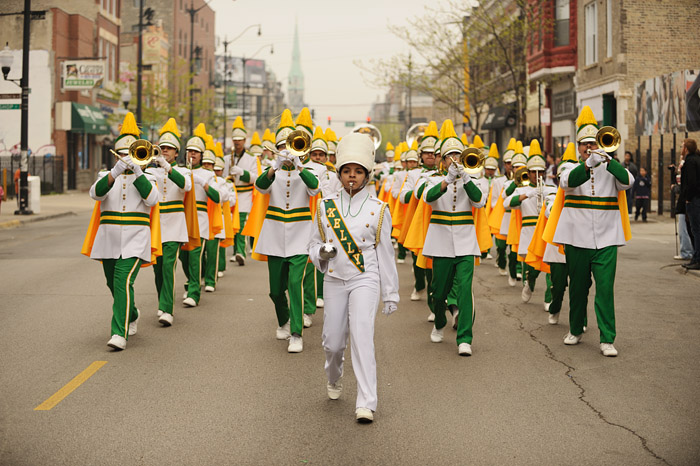 That would be the band! The scene of this marching is the Pilsen neighborhood of Chicago, but bands are everywhere in the fall, parading down the street and then stepping out spectacularly onto the fields of glory. The inimitable Professor Harold Hill of Gary, Indiana, whose Think Method of musical instruction worked well enough till his encounter in Iowa with Marian the librarian, probably said it best: "I always think there's a band, son."
That would be the band! The scene of this marching is the Pilsen neighborhood of Chicago, but bands are everywhere in the fall, parading down the street and then stepping out spectacularly onto the fields of glory. The inimitable Professor Harold Hill of Gary, Indiana, whose Think Method of musical instruction worked well enough till his encounter in Iowa with Marian the librarian, probably said it best: "I always think there's a band, son."
Oct 24, 2012
 Almost nothing is known about this photo, which apparently showed up recently in a secondhand store in Vancouver, British Columbia.
Almost nothing is known about this photo, which apparently showed up recently in a secondhand store in Vancouver, British Columbia.
Dominion Photo Company, which takes credit for the picture, operated in Vancouver for about fifty years, beginning in 1914. The fashions on display here, in clothing and music, not to mention the light fixtures and potted palms, suggest the 1930s?
We would imagine that when all those dozens of lap guitars got to strumming, the sound of the islands would have really filled up a room. Thanks to the magic of YouTube, master slide guitarist Johnny Pal shows how it was done.
Oct 30, 2012
 Philadelphia rode out the storm without much incident; lots of rain and small tree branches fell, and then that was that. We were the lucky ones this time.
Philadelphia rode out the storm without much incident; lots of rain and small tree branches fell, and then that was that. We were the lucky ones this time.
Although I haven't checked up on it with my own eyes, I'd lay money that this mural on East Passyunk is still standing. The performers celebrated on this wall–in autographed portraits designed by mural artist Peter Pagast to resemble the framed celebrity photos on a restaurant wall–were all born and raised in South Philadelphia: Frankie Avalon, Chubby Checker, Fabian, Bobby Rydell, Al Martino, Eddie Fisher, and in the upper right corner someone not so well known among us ignorant non-Philadelphia natives: disc jockey Jerry Blavat.
In 2005, when the mural was dedicated, all of them except Eddie Fisher showed up for a celebratory sock hop.
Nov 17, 2012
Fair Oaks District, Centreville Rd., 2300 block, Dec. 7. Animal control was called about a squirrel running inside a residence. When an animal control officer saw the squirrel, it jumped into an open baby grand piano. After the officer started playing the song "All I Want" by the group Toad the Wet Sprocket, the squirrel jumped out of the piano and onto curtains, damaging them. The squirrel then jumped onto the officer's head and pounced onto a couch, where the officer was able to catch it. The officer released the animal outside. Neither the squirrel nor the officer was injured.
(Reprinted from the February 12, 2001, edition of New Yorker magazine.)
Nov 18, 2012
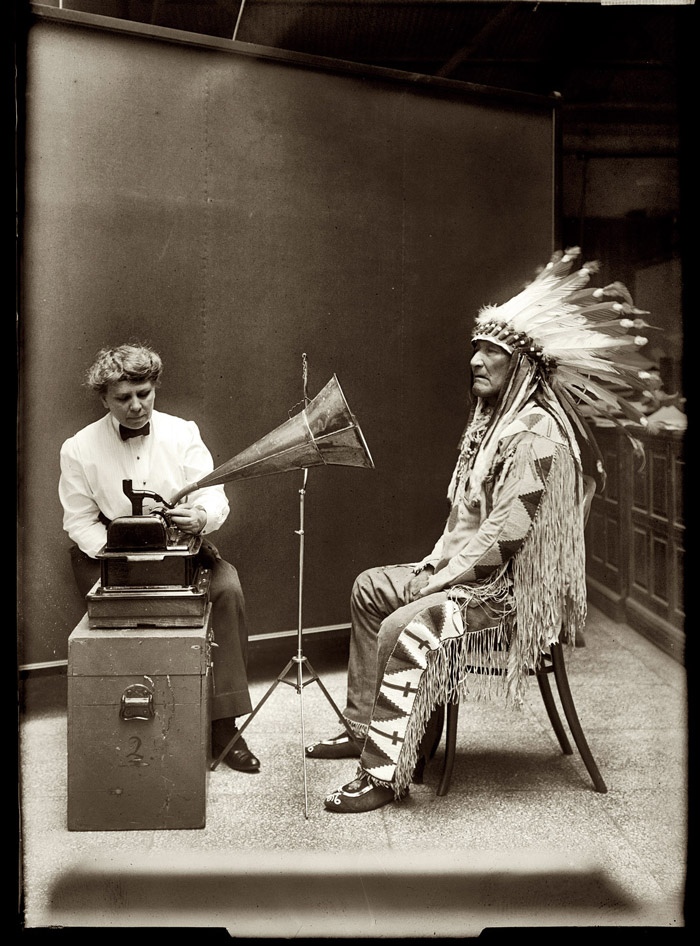 In 1916, the Mountain Chief of the Piegan Blackfeet participated in a recording session with ethnologist Frances Densmore, who traveled the American West collecting Native music and reminiscences. The songs were recorded on wax cylinders and later pressed on vinyl.
In 1916, the Mountain Chief of the Piegan Blackfeet participated in a recording session with ethnologist Frances Densmore, who traveled the American West collecting Native music and reminiscences. The songs were recorded on wax cylinders and later pressed on vinyl.
In recent years, the Smithsonian has reissued much of the music, including a CD featuring a photo taken at the same time as this one. But the Blackfeet songs on the Smithsonian CD were all recorded no earlier than the 1930s. They are typical of Plains Indian songs, with elaborate vocalizations but very few words.
It is said that earlier Blackfeet songs, perhaps including the ones sung by this chief in 1916, had many more words and told long, complicated stories. Like so much of Native culture, it seems, the words are all gone now, and the singers have to try to sing without them.
Nov 27, 2012
 In the awkward but sort of proud tradition of bloggers promoting cool stuff from their friends and relations, we are pleased as punch to point you to Savvy Lessons, the new venture by Ted Stein and his partners Brad Clements and Bhagwan Khalsa.
In the awkward but sort of proud tradition of bloggers promoting cool stuff from their friends and relations, we are pleased as punch to point you to Savvy Lessons, the new venture by Ted Stein and his partners Brad Clements and Bhagwan Khalsa.
Dec 28, 2012
 The Roches–sisters Maggie, Terre, and Suzzie–don't always sing like this, but when they do, they're from New Jersey.
The Roches–sisters Maggie, Terre, and Suzzie–don't always sing like this, but when they do, they're from New Jersey.
May 9, 2013
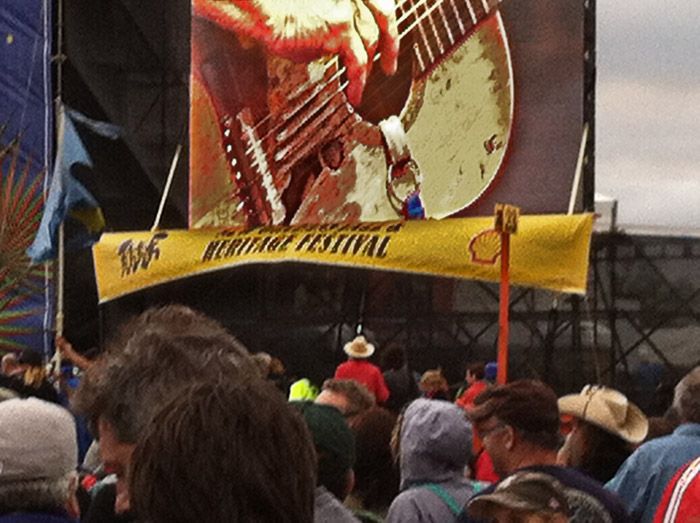 Willie Nelson's guitar, Trigger, is almost as old and torn up as Willie himself. Willie marked his eightieth birthday with a show last weekend at the 2013 New Orleans Jazz Fest; Trigger's been his concert workhorse for forty years now, ever since a drunk stepped on his prize Gibson guitar and he needed a replacement fast, from off the shelf.
Willie Nelson's guitar, Trigger, is almost as old and torn up as Willie himself. Willie marked his eightieth birthday with a show last weekend at the 2013 New Orleans Jazz Fest; Trigger's been his concert workhorse for forty years now, ever since a drunk stepped on his prize Gibson guitar and he needed a replacement fast, from off the shelf.
Trigger is a classical-style guitar with with an electric pickup attached. It was meant to be played acoustically, strummed with the fingers, not amplified with a pick, and forty years of picking have worn right through the wood on the front face, leaving a big hole that's getting bigger.
There are also scrapes and scratches and dings and cracks, all of which seem completely predictable for anything in Willie Nelson's life, even something as precious to him as Trigger. And then there are the autographs, more than a hundred by now, beginning with Leon Russell and including the names of fellow musicians, friends, and of course his lawyers. The signatures are scratched into the wood, not inked on the surface; the cellphone camera failed to pick them out clearly.
Jazz Fest weather in New Orleans is supposed to be hot and humid; there may be rain and mud, but always there should be sweat and sunburn. This year, Willie and all the other performers sang into a hard, cold wind, nothing like what's normal for New Orleans in May. Most festival-goers were not prepared for the shivery conditions, but the music definitely took the edge off the chill.
Oct 28, 2013
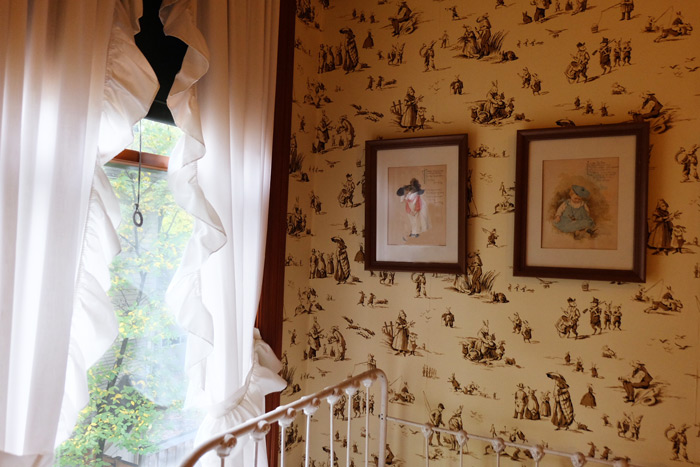 Maud Humphrey, born in 1868 in upstate New York, educated at New York City's new Art Students League and then, of course, in Paris, was a rare creature in her place and time: a highly successful professional woman who managed to combine a brilliant career with conventional marriage and family life. She married a doctor but out-earned him several times over, producing commercial artwork for immensely popular books, magazines, and advertising campaigns; she specialized in sentimental watercolor illustrations that featured plump children and adorable animals. Think: Gerber baby.
Maud Humphrey, born in 1868 in upstate New York, educated at New York City's new Art Students League and then, of course, in Paris, was a rare creature in her place and time: a highly successful professional woman who managed to combine a brilliant career with conventional marriage and family life. She married a doctor but out-earned him several times over, producing commercial artwork for immensely popular books, magazines, and advertising campaigns; she specialized in sentimental watercolor illustrations that featured plump children and adorable animals. Think: Gerber baby.
Jan 21, 2014
 On Sunday afternoon, there was nyckelharpa music in the air at Third Street Gallery on Second Street (don't ask) in Philadelphia's Old City.
On Sunday afternoon, there was nyckelharpa music in the air at Third Street Gallery on Second Street (don't ask) in Philadelphia's Old City.
That doesn't happen too often in Philly or really anywhere in the United States, with the possible exception of the Seattle area, home to the American Nyckelharpa Association and site of occasional dance evenings accompanied by nyckelharpists.
In Sweden, on the other hand, there are an estimaed 10,000 nyckelharpa players, and the keyed fiddle is featured on the back of the 50-krona note and has in fact been declared the country's official musical instrument. Swedes have been building and playing and composing music for nyckelharpor for more than six hundred years. Five-hundred-year-old stained glass windows feature angels playing the nyckelharpa.
The modern version of the instrument has 16 strings, 4 of which are played by the bow; the other 12 vibrate sympathetically, producing a resonant, vaguely organ-like sound.
The bowed string on the upper side of the neck, closest to the player's body, is a drone, unaffected by the keys and used rarely. The other three bowed strings can be shortened by pressing different keys to produce several octaves' worth of tones; there are three rows of keys, each dedicated to a different string.
Most nyckelharpa music harks back to folksong or polka, but the instrument is used by a handful of Swedish rock bands, and some serious musicians can play pretty much anything on it, such as Bach's Partita No. 2 in D Minor.
The nyckelharpa occasion on Sunday was a reception for an art show featuring two Philly-area artists: Judith Schermer, who exhibited twelve paintings of clotheslines, and Priscilla Snow Algava, who showed a variety of drawings and paintings of "matriarchs and sages."
Aug 24, 2014
On Saturday morning, geophysicists believed Iceland's Bardarbunga volcanic system had begun erupting beneath the huge glacier that hides it from view. By Saturday evening, however, new data or new interpretations of the data were raising doubts about this conclusion; the magma might still be trapped in rock a few kilometers below the bottom of the ice.
The actual eruption might have already begun or might begin at any moment or might never happen at all. But Bardarbunga's magma is definitely on the move down there in the earth's crust, melting some of the rock in its path and shouldering the rest out of its way, along a northeasterly route tracked by literally thousands of earthquakes.
Halldor Eldjarn has set the earthquake data to music, which you can listen to in near-real time.
Nov 22, 2014
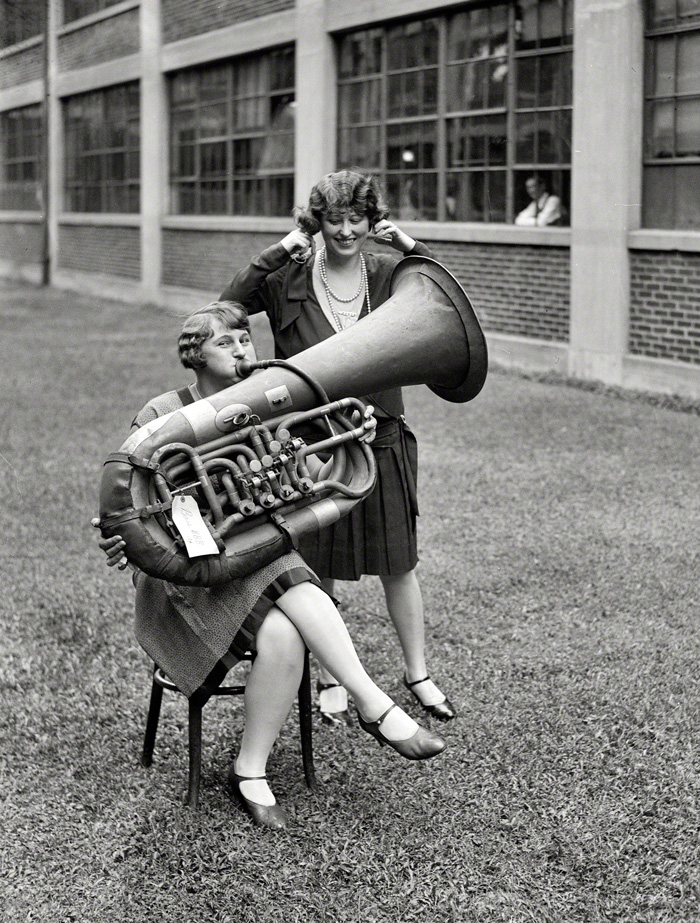 The musical instrument in the 1928 photo above is a contrabass tuba, considerably larger and lower-pitched than a regular tuba. It is designed to be strapped onto a musician in a marching band and played in its strapped-on position, without need for lifting or rearranging.
The musical instrument in the 1928 photo above is a contrabass tuba, considerably larger and lower-pitched than a regular tuba. It is designed to be strapped onto a musician in a marching band and played in its strapped-on position, without need for lifting or rearranging.
The extremely rare instrument in the photo below from Greenwich, England, is a sub-contrabass tuba, which emits sounds an octave lower than those produced by the contrabass tuba. It is probably not intended for use in a marching band.
Jan 24, 2015
 This is the front panel of a Nechada barrel organ, made in Odessa, Ukraine, in the early years of the twentieth century. It was often set up in the street outside a bar or brothel, in hopes that the popular tunes it blasted out would draw a crowd of potential customers. Sometimes, of course, the organ grinder had a monkey as an added attraction, or a troupe of very young girls, perhaps eight or ten years old, who danced and sang and turned cartwheels to entertain the drunks.
This is the front panel of a Nechada barrel organ, made in Odessa, Ukraine, in the early years of the twentieth century. It was often set up in the street outside a bar or brothel, in hopes that the popular tunes it blasted out would draw a crowd of potential customers. Sometimes, of course, the organ grinder had a monkey as an added attraction, or a troupe of very young girls, perhaps eight or ten years old, who danced and sang and turned cartwheels to entertain the drunks.
Odessa was home to a number of piano manufacturers, who made these organs as a sideline. No musical skill was required to operate them; the organ grinder just turned the crank on one side of the box, which pumped air through the organ pipes and also spun rolls of paper that had been pre-programmed with the desired musical compositions. The paper blocked air from entering the pipes except where holes had been punched; when a hole in the paper came in line with the opening to a pipe of the desired pitch, air was forced through the pipe, generating each note of a song.
Odessa street organs, called sharmankas, were sold throughout the Russian empire from about 1860 until they began to be replaced by more modern music machines, notably record players, in the 1920s. Even then, they remained in use by street buskers, particularly in Tbilisi and other Georgian cities, where street organs were popular well into the 1960s.
The inscription across the bottom of this organ gives the name and address of its maker. Ivan Viktorovich Nechada worked out of a piano factory on Balskovskaya Street, now Isaac Babel Street, in Odessa. This organ is in the collection of the new Musical Instrument Museum in Phoenix, Arizona, but recently a very similar Nechada organ, said to be in perfect working order, was advertised in Moscow; "May be sold or exchanged for a car," wrote the seller, in an ad in Mechanical Music Digest.
Feb 14, 2015
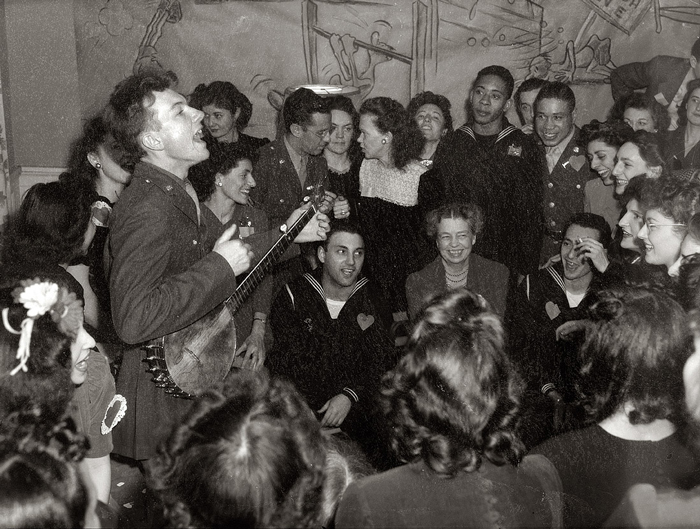 Guest of honor at this Valentine's Day party in 1944 was Eleanor Roosevelt; serenading her was a soldier by the name of Pete Seeger.
Guest of honor at this Valentine's Day party in 1944 was Eleanor Roosevelt; serenading her was a soldier by the name of Pete Seeger.
The gathering celebrated not only Valentine's Day but also the grand opening of the new Labor Canteen of the United Federal Workers of America, CIO, near Dupont Circle in Washington, D.C.
United Federal Workers was a labor union representing U.S. government employees. Though soldiers and sailors were certainly not unionized, they may have frequented the new canteen for political and/or social activities.
The UFW included both black and white members. But the scene in this room was extremely unusual for 1940s Washington, which was still a completely segregated city. The military was also still segregated. Eleanor Roosevelt's presence was making a political statement about race as well as labor.
The cartoons on the wall in the background may have been the work of Woody Guthrie.
As some of you will surely point out, the banjo Pete Seeger is playing here does not look like the long-necked music machine he was long associated with. That one came a few years later.
Happy Valentine's Day 2015.
Mar 3, 2015
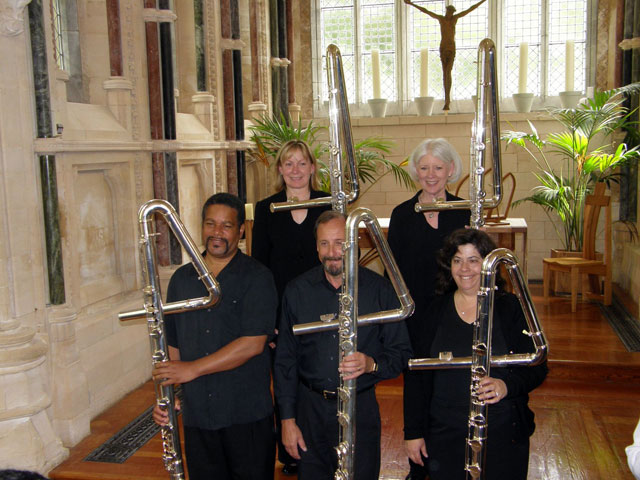
The contraflutes of the Metropolitan Flute Orchestra, at Kylemore Abbey in Connemara, County Galway, in the west of Ireland. The three flautists in the front row are holding contrabass flutes tuned in C; behind them are two sub contrabass flutes in G.
There is also a double contrabass flute, which is capable of playing the lowest C on a piano. Its tone sounds even lower, we're told, because flutes have fewer harmonic vibrations than stringed instruments.
To hear a little contrabass fluting and see how the dang things are held and played, try this.